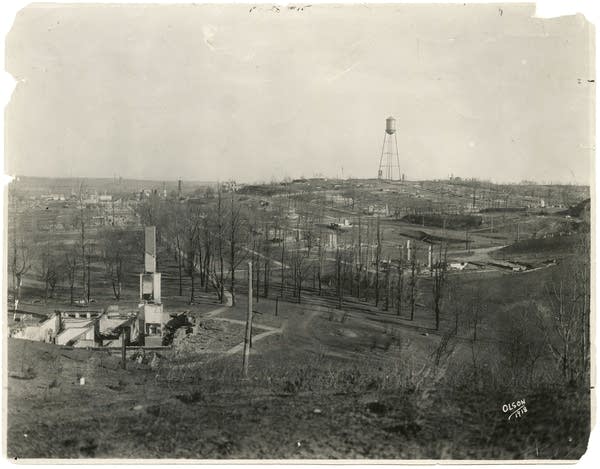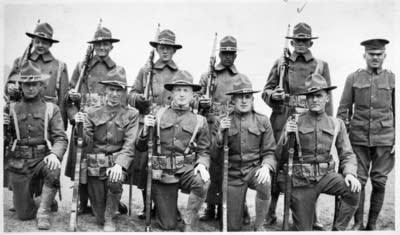Why 1918 was so awful in Minnesota

In Minnesota, the year 1918 was devastating.
Thousands of Minnesotans died on faraway battlefields during World War I. Back home, thousands more died from a deadly strain of influenza. Then there were the fires: In October 1918, fires sparked by trains grew to consume 1500 square miles of northeastern Minnesota, killing hundreds of people.

Author and Star Tribune columnist Curt Brown documents this history in his latest book "Minnesota, 1918: When Flu, Fire, and War Ravaged the State."
Brown talked with MPR News host Cathy Wurzer about what he found — starting with just how deadly this year was.
Create a More Connected Minnesota
MPR News is your trusted resource for the news you need. With your support, MPR News brings accessible, courageous journalism and authentic conversation to everyone - free of paywalls and barriers. Your gift makes a difference.
Brown: I don't think people are really aware that this was the deadliest natural disaster in Minnesota history. Four hundred fifty people died in the fire. And then if you were lucky enough to have survived the fire, you got crammed into evacuee housing where you caught the flu. And there were more than 100 documented cases of fire survivors then dying of the flu. So it was a real one-two punch, and a lot of these people were worried about their brothers off fighting in the trenches and mustard gas of World War I. And by the time those guys got home from the war, which ended of course in November of 1918, a lot of times many members of their family had died either from the flu or in the fire. So it was a trifecta woe.
Wurzer: These are hair-raising stories. I've had the opportunity, as you have had, to go through some of the archives at the Moose Lake Historical Society and the Carlton County Historical Society in Cloquet. I mean, I don't think people truly understand how fast these fires swept across that area of Minnesota.

Brown: And the other harrowing thing, cars were still kind of a new thing in 1918. So a lot of early Model Ts and a lot of people fleeing the fires piled in eight, 12 people in an old Model T and there's a place up there near Moose Lake called Dead Man's Curve now, where more than 75 people died. And basically they were fleeing the fire at high speeds, a lot of the cars crashed over. And not only was this huge pileup of cars, then the fires overtook the people who were trying to get away from this car crash. So it was a double-headed monster of a disaster.
Wurzer: Toward the end of the book, you have more recollections from a woman who was quite young at the time. Her family fled their farm and headed toward Cloquet, and she was in a horse-drawn wagon with her family. And she said the smoke was so thick she couldn't even see her siblings who were in the same wagon with her. I mean, I can't even imagine that.
Brown: A lot of people wondered if they were the last ones left, like on Earth. It was that horrible of a thing. And there was one story of a woman, she was a girl at the time, who had kind of got lost in the fire and was wandering these charred woods and sat down on a log to rest and realized it wasn't a log but it was a corpse of someone she knew from school. So I mean the stories are horrible, but there's also a sense of resiliency that I hope comes out of the book, that people do survive these horrible things and maybe come out stronger, I hope.
Wurzer: As you combed through all the research — and I know it's taken you a long time to do this — there are some great oral histories, and some of those smaller historical societies in northeastern Minnesota have done a great job documenting this history. But as you know, when you get yourself involved in this there's always a surprise or two in the research. What jumped out at you?
Brown: Well I think my favorite character that appeared, Cathy, was a woman named Anna Dickie Olesen. She was the superintendent's wife up in Cloquet at the time. Four years later, she made history as the first woman to run for the U.S. Senate.
Wurzer: And I didn't know that until I read your book.
Brown: Yeah, as a major party candidate. She lost as a Democrat, but her family — her and her husband had moved to Northfield where he got a job at Carleton teaching, I think it was German and he was the registrar — but she continued to fight for these survivors and tried to get them the benefits that they deserved. And in 1930, eighteen [sic] years after the fire, she went in front of a claims committee at Congress and made an impassioned plea to give these people the money they needed. These were poor immigrants, she said. She didn't like people laughing at their broken English, and they needed to be made whole. And so she came out as really one of the strong characters, and my favorite character in the book.
Wurzer: I did not know that she was such a pioneering politician in the state. I mean, her story's kind of been lost.
Brown:And William Jennings Bryan was a popular speaker at the time. And so she would join him across the country and was kind of a national celebrity by the early '20s. But again, back in 1918 she was the superintendent's wife who survived the fire, and jumped on some of these railroad cars that led a lot of people to safety. Thousands were saved in Cloquet by the same trains that were later blamed then for starting the fires.
Comments have been edited for length and clarity.
Use the audio player above to hear the conversation.


